One-to-One Correspondence
One-to-one correspondence is a fundamental concept in mathematics that relates to the pairing of elements in two sets such that each element in one set is paired with exactly one element in the other set. This concept is crucial for understanding the idea of counting and comparing the quantities of different sets.
Key Concepts:
- Pairing: In one-to-one correspondence, each element in one set is paired with exactly one element in the other set, and vice versa.
- Uniqueness: Each element in one set must have a unique pairing with an element in the other set, and no element can be left unpaired.
- Counting: One-to-one correspondence is often used in counting to ensure that each object in a set is counted exactly once.
Examples:
Consider the following examples to understand one-to-one correspondence:
Example 1:
Pairing the elements of Set A = {a, b, c} with the elements of Set B = {1, 2, 3} in a one-to-one correspondence:
- a is paired with 1
- b is paired with 2
- c is paired with 3
Example 2:
Counting the number of students and the number of desks in a classroom using one-to-one correspondence, where each student is paired with exactly one desk.
Study Guide:
To master the concept of one-to-one correspondence, follow these study guidelines:
- Understanding Pairing: Practice pairing elements of different sets to ensure that each element has a unique pairing in a one-to-one correspondence.
- Real-life Examples: Look for real-life examples where one-to-one correspondence is used, such as counting objects or matching items in pairs.
- Counting Practice: Practice counting objects using one-to-one correspondence to ensure that each object is counted exactly once.
- Problem-solving: Solve problems that involve matching elements in sets using one-to-one correspondence.
◂Math Worksheets and Study Guides Seventh Grade. Nonlinear Functions and Set Theory
Study Guide Nonlinear Functions and Set Theory
Nonlinear Functions and Set Theory  Worksheet/Answer key
Worksheet/Answer key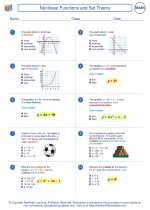 Nonlinear Functions and Set Theory
Nonlinear Functions and Set Theory  Worksheet/Answer key
Worksheet/Answer key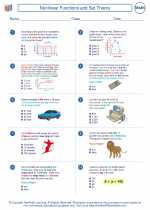 Nonlinear Functions and Set Theory
Nonlinear Functions and Set Theory  Worksheet/Answer key
Worksheet/Answer key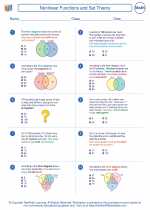 Nonlinear Functions and Set Theory
Nonlinear Functions and Set Theory  Worksheet/Answer key
Worksheet/Answer key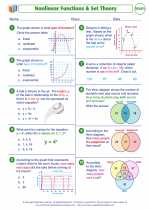 Nonlinear Functions and Set Theory
Nonlinear Functions and Set Theory  Worksheet/Answer key
Worksheet/Answer key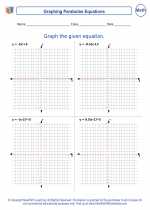 Parabolas
Parabolas 

 Worksheet/Answer key
Worksheet/Answer key
 Worksheet/Answer key
Worksheet/Answer key
 Worksheet/Answer key
Worksheet/Answer key
 Worksheet/Answer key
Worksheet/Answer key
 Worksheet/Answer key
Worksheet/Answer key

The resources above cover the following skills:
Algebra (NCTM)
Represent and analyze mathematical situations and structures using algebraic symbols.
Explore relationships between symbolic expressions and graphs of lines, paying particular attention to the meaning of intercept and slope.
Analyze change in various contexts.
Use graphs to analyze the nature of changes in quantities in linear relationships.